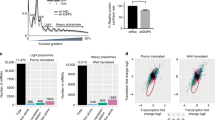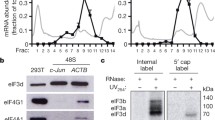Abstract
BAG-1 (also known as RAP46/HAP46) was originally identified as a 46 kDa protein that bound to and enhanced the anti-apoptotic properties of Bcl-2. BAG-1 exists as three major isoforms (designated p50, p46 and p36 or BAG-1L, BAG-1M and BAG-1S respectively) and one minor isoform (p29), which are translated from a common transcript. The differing amino terminus determines both the intracellular location and the repertoire of binding partners of the isoforms which play different roles in a variety of cellular processes including signal transduction, heat shock, apoptosis and transcription. Although in vitro data suggest that the four BAG-1 isoforms are translated by leaky scanning, the patterns of isoform expression in vivo, especially in transformed cells, do not support this hypothesis. We have performed in vivo analysis of the BAG-1 5′ untranslated region and shown that translation initiation of the most highly expressed isoform (p36/BAG-1S) can occur by both internal ribosome entry and cap-dependent scanning. Following heat shock, when there is a downregulation of cap-dependent translation, the expression of the p36 isoform of BAG-1 is maintained by internal ribosome entry.






Similar content being viewed by others
References
Bimston DN, Song J, Winchester D, Takayama S, Reed JC, Morimoto RI . 1998 EMBO J. 17: 6871–6878
Coldwell MJ, Mitchell SA, Stoneley M, MacFarlane M, Willis AE . 2000 Oncogene 19: 899–905
Cornelis S, Bruynooghe Y, Denecker G, Van Huffel S, Tinton S, Beyaert R . 2000 Mol. Cell 5: 597–605
Cuesta R, Laroia G, Schneider RJ . 2000 Genes Dev. 14: 1460–1470
Gray N, Wickens M . 1998 Ann. Rev. Cell Dev. Biol. 14: 399–458
Henis-Korenblit S, Levy N, Strumpf N, Goldstaub D, Kimchi A . 2000 Mol. Cell. Biol. 20: 496–506
Holcik M, Yeh C, Korneluk RG, Chow T . 2000 Oncogene 19: 4174–4177
Jordan M, Schallhorn A, Wurm FM . 1996 Nucleic Acids Res. 24: 596–601
Kozak M . 1986 Cell 44: 283–292
Luders J, Demand J, Papp O, Hohfeld J . 2000 J. Biol. Chem. 275: 14817–14823
Lüscher B, Eisenman RN . 1988 Mol. Cell. Biol. 8: 2504–2512
Nollen EAA, Brunsting JF, Song J, Kampinga HH, Morimoto RI . 2000 Mol. Cell. Biol. 20: 1083–1088
Packham G, Brimmell M, Cleveland JL . 1997 Biochem. J. 328: 807–813
Rhoads RE, Lamphear BJ . 1995 Curr. Top. Microbiol. Immunol. 203: 131–153
Schneider RJ . 2000 Translational Control of Gene Expression. Sonenberg N, Hershey JWB and Mathews MB. (eds). Cold Spring Harbor Laboratory pp. 581–593
Stoneley M . 1998 PhD thesis. University of Leicester. Title: Functional analysis of the 5′ untranslated region of the c-myc proto-oncogene
Stoneley M, Paulin FEM, Le Quesne JPC, Chappell SA, Willis AE . 1998 Oncogene 16: 423–428
Stoneley M, Chappell SA, Jopling CL, Dickens M, MacFarlane M, Willis AE . 2000a Mol. Cell. Biol. 20: 1162–1169
Stoneley M, Subkhankulova T, Le Quesne JPC, Coldwell MJ, Jopling CL, Belsham GJ, Willis AE . 2000b Nucleic Acids Res. 28: 687–694
Stuart JK, Myszka DG, Joss L, Mitchell RS, McDonald SM, Xie Z, Takayama S, Reed JC, Ely KR . 1998 J. Biol. Chem. 273: 22506–22514
Takayama S, Sato T, Krajewski S, Kochel K, Irie S, Millan JA, Reed JC . 1995 Cell 80: 279–284
Takayama S, Kochel K, Irie S, Inazawa J, Abe T, Sato T, Druck T, Huebner K, Reed JC . 1996 Genomics 35: 494–498
Takayama S, Krajewski S, Krajewska M, Kitada S, Zapata JM, Kochel K, Knee D, Scudiero D, Tudor G, Miller GJ, Miyashita T, Yamada M, Reed JC . 1998 Cancer Res. 58: 3116–3131
Vagner S, Gensac M-C, Maret A, Bayard F, Amalric F, Prats H, Prats A-C . 1995 Mol. Cell. Biol. 15: 35–44
Vagner S, Touriol C, Galy B, Gensac MC, Amalric F, Bayard F, Prats H, Prats A-C . 1996 J. Cell. Biol. 135: 1391–1402
Wang H-G, Takayama S, Rapp UR, Reed JC . 1996 Proc. Natl. Acad. Sci. USA 93: 7063–7068
West MJ, Stoneley M, Willis AE . 1998 Oncogene 17: 769–780
Yang G, Sarnow P . 1997 Nucleic Acids Res. 25: 2800–2807
Yang X, Chernenko G, Hao Y, Ding Z, Pater MM, Pater A, Tang S-C . 1998 Oncogene 17: 981–989
Yueh A, Schneider RJ . 2000 Genes Dev. 14: 414–421
Zeiner M, Gehring U . 1995 Proc. Natl. Acad. Sci. USA 92: 11465–11469
Acknowledgements
This research was supported by grants from the BBSRC (advanced research fellowship to AE Willis), the LRF (ML de Schoolmeester) and the AICR (grant held by G Packham). MJ Coldwell and BM Pickering hold MRC studentships. We thank Fiona Wilson for some of the early cell line work.
Author information
Authors and Affiliations
Corresponding author
Rights and permissions
About this article
Cite this article
Coldwell, M., deSchoolmeester, M., Fraser, G. et al. The p36 isoform of BAG-1 is translated by internal ribosome entry following heat shock. Oncogene 20, 4095–4100 (2001). https://doi.org/10.1038/sj.onc.1204547
Received:
Revised:
Accepted:
Published:
Issue Date:
DOI: https://doi.org/10.1038/sj.onc.1204547
- Springer Nature Limited
Keywords
This article is cited by
-
Research progress on the tsRNA classification, function, and application in gynecological malignant tumors
Cell Death Discovery (2021)
-
BAG-1L Protects SH-SY5Y Neuroblastoma Cells Against Hypoxia/Re-oxygenation Through Up-Regulating HSP70 and Activating PI3K/AKT Signaling Pathway
Neurochemical Research (2017)
-
Controlling gene expression in response to stress
Nature Reviews Genetics (2011)
-
Expression patterns and prognostic value of Bag-1 and Bcl-2 in breast cancer
Breast Cancer Research (2008)
-
A gastrin transcript expressed in gastrointestinal cancer cells contains an internal ribosome entry site
British Journal of Cancer (2008)




